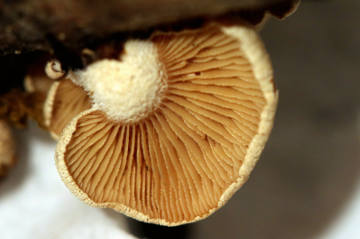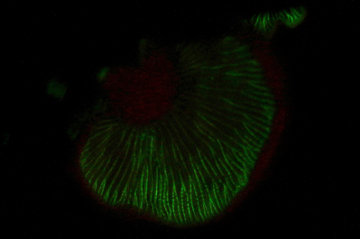

PHOTO COURTESY OF GARRY KESSLER
Gills on the underside of a night light mushroom cap (greatly enlarged in this photo) in daylight.
December 2, 2016, Page A8
NATURE NOTES
By Annie Reid
Westborough Community Land Trust
Green-glowing Mushrooms
Green-glowing mushrooms? Sounds like a left-over Halloween decoration, or a something escaped from the 1960s. But yes, we have mushrooms that glow in the dark in our local woods.
The night light (Panellus stipticus) is a small, common mushroom that appears in shelf-like clusters on decaying logs and stumps in our woods. When it’s fresh, its gills can give off a greenish glow in the dark of night. People have long referred to this eerie glow as “foxfire.” Another name for the night light fungus is luminescent panellus.
Most of us aren’t out in the woods on dark, moonless nights to see the glow of these mushrooms. The glow can be hard to see because it comes from the gills on the underside of the mushroom caps.
People sometimes bring home a dead branch or other chunk of wood with these mushroom caps growing on it. They look for the glow in the middle of the night, or inside a totally dark closet. Note that to see the glow, human eyes first need to adjust to darkness, which takes up to 15 minutes in darkness. (The green glow captured in our photo came from the mushroom cap in a closet at night, during a 20-minute exposure.)
What causes these mushrooms to glow? The green light is a kind of bioluminescence, a chemical reaction caused in living things by an enzyme that acts on a certain pigment. Helped along by the enzyme, the pigment gives off light when it combines with oxygen. (The enzyme is called luciferase and the pigment is named luciferin – both from the name Lucifer, meaning “bearer of light,” and often associated with the devil.)

PHOTO COURTESY OF GARRY KESSLER
Gills on the underside of the same night light mushroom cap (greatly enlarged in this photo) at night in a dark closet. (Photographed with a 20 minute exposure time.)
You may have seen bioluminescence when fireflies flash at night in the summertime. Also, many ocean creatures are bioluminescent, including types of algae, worms, jellyfish, crustaceans, sea stars, fish, and even sharks. In some cases these creatures produce their own glow, and in other cases they have bioluminescent bacteria living inside them. These days scientists can insert genes for luminescence into cells or organisms so they will glow in response to certain experimental conditions.
Interestingly, night light mushrooms are found around the world in Europe, Asia, and Australia as well as North America, but the only ones that glow are in our area – the northeastern U.S.
To glow, the night light mushroom must be fresh, although dried-out mushrooms that have been revived in water are sometimes still capable of glowing. The mushrooms typically appear July through the fall and even winter, but you can find the caps year-round. No one really knows why mushrooms glow.
The caps of night light are small, only about an inch across, and usually somewhat kidney-shaped with slightly scalloped, in-rolled edges. Fresh caps are slightly soft and pliable, with gills. They grow out horizontally from dead wood, on short stalks that are attached off-center on the caps. Their color is tan to yellowish or orange. The gills are close together and some are forking or interconnected.
Look for night light growing on dead oak, birch, and maple, or other hardwoods. Its spores – which fall from its gills – are white. To tell the color of the spores, make a spore print by setting a cap on a piece of white or black paper (with the gill side down) overnight. Then look at the color of the spores on the paper. (White spores show up best on black paper, such as black construction paper.)
Are night light mushrooms edible? The answer is no. They are known to have an acrid, bitter taste, which has given this mushroom another name – bitter oyster. One old-time use for the mushroom was to induce vomiting. Slugs and our white-tailed deer can eat these mushrooms, but we can’t.
Another traditional use was as a styptic, to help stop bleeding. This involved applying it externally to the bleeding area. The word “stipticus,” used since 1783 in the scientific name Panellus stipticus, reflects this use.
Like so many other fungi, night light mushrooms are useful in nature’s grand recycling process. The main body of the fungus exists as thin white threads growing throughout dead wood, creating “white rot” as they give off chemicals that break down wood. This natural breakdown process frees up nutrients for the fungus and other life to absorb and use. White rot takes place when the brown lignin in wood is digested in this way, leaving behind much light-colored cellulose.
Night light has been investigated for possible use in degrading environmental pollutants, such as those left over from processing olive products in Mediterranean countries, or in detecting pollutants. (For example, the fungus could serve as a detector if the strength of its glow were related to the presence of a particular chemical.)
Surprisingly, the night light fungus is not the only one that glows in the dark. Would you believe that more than 70 such species exist in the world? Some, such as the orange mushrooms known as jack o’lantern (Omphalotus olearius), are also found in our woods.
Think of these mushrooms when you’re out enjoying the late fall and winter woods, even if you don’t see them glow.
Date index
Month (December)
Common name index
Scientific name index
Category index